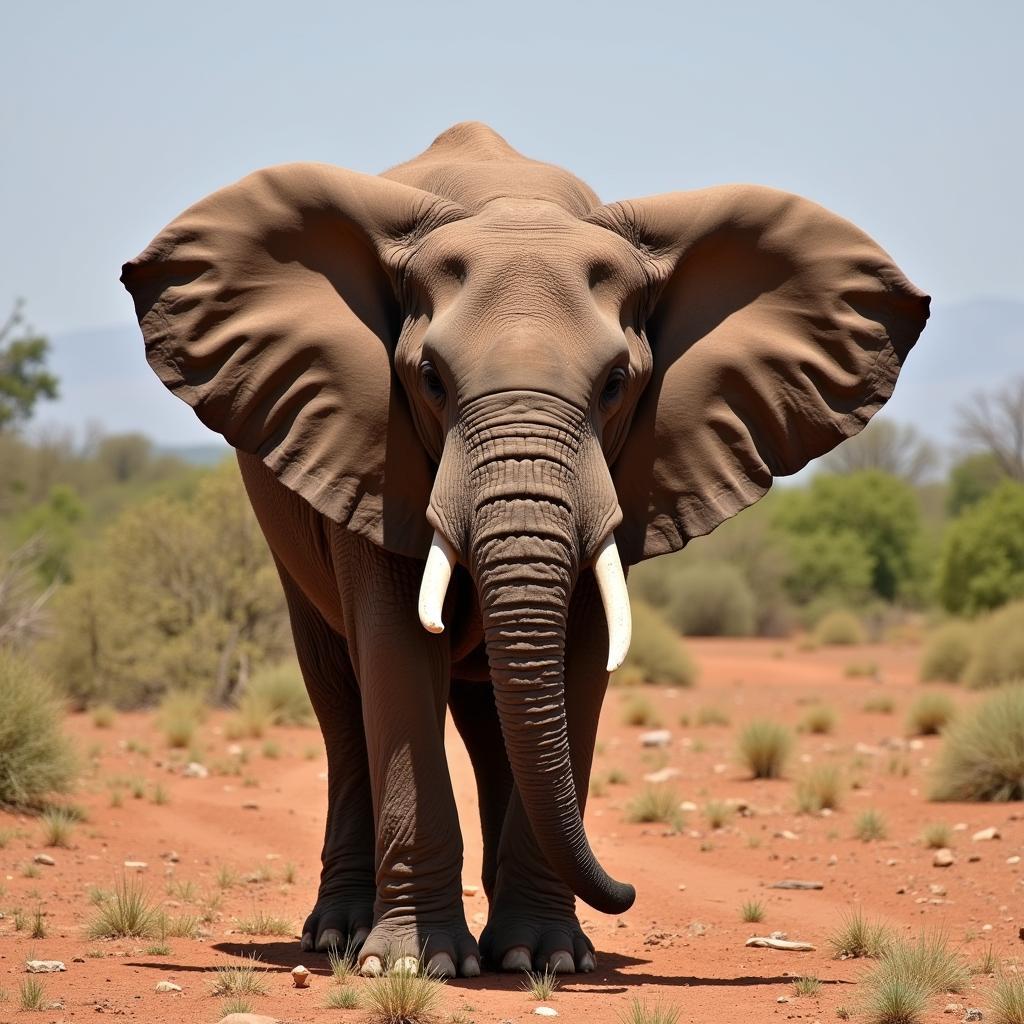Exploring the Remarkable African Elephant Body Parts
African Elephant Body Parts are a marvel of natural engineering, perfectly adapted to their environment and lifestyle. From their iconic tusks and massive ears to their surprisingly agile trunks and powerful legs, each part plays a crucial role in the elephant’s survival. Understanding the function and significance of these body parts provides a deeper appreciation for these magnificent creatures. Let’s delve into the fascinating world of African elephant anatomy.
The Iconic Tusks and Powerful Trunk: Symbols of the African Elephant
Perhaps the most recognizable African elephant body parts are their tusks. These elongated teeth, made of ivory, serve a multitude of purposes, from digging for water and minerals to stripping bark from trees and defending against predators. Sadly, these magnificent tusks have also been the cause of much suffering, driving the illegal ivory trade and putting elephant populations at risk. Learn more about the threats faced by these gentle giants and the efforts to protect them. The African elephant’s trunk is another remarkable feature, a fusion of the nose and upper lip that acts as a versatile tool. It’s used for breathing, smelling, touching, grasping, and even communicating, capable of producing a wide range of sounds from low rumbles to loud trumpets.
The African elephant’s trunk is truly a marvel of nature, allowing it to perform a vast array of tasks with incredible precision. For example, it can pick up a single blade of grass or tear down a branch from a tree. This incredible dexterity is thanks to the intricate network of muscles and nerves within the trunk. These muscles also allow the elephant to use its trunk like a snorkel when crossing deep rivers. Speaking of rivers, some elephants are even known to inhabit desert regions, like the fascinating African desert elephant. Did you know some African deer also possess striking spiral horns? You can explore this further by reading about the African deer with spiral horns.
Ears That Hear More Than Sound: Thermoregulation and Communication
The enormous ears of the African elephant are another defining characteristic. These impressive appendages aren’t just for hearing; they play a vital role in thermoregulation, helping the elephant stay cool in the hot African sun. The large surface area of the ears is rich with blood vessels, allowing heat to dissipate quickly. The elephant can also flap its ears to create air currents, further enhancing cooling. Interestingly, the shape of the African elephant’s ears can also be used to distinguish them from their Asian counterparts. To learn more about these differences, take a look at the difference between African and Asian elephants.
Besides thermoregulation, the ears also play a role in communication. Elephants can use their ears to signal aggression, excitement, or submission. The subtle movements and positioning of the ears provide valuable cues to other elephants, allowing for complex social interactions within the herd. These large ears can also pick up low-frequency sounds, enabling elephants to communicate over long distances. This is crucial for maintaining social bonds and coordinating movements within their vast territories.
 African Elephant Ears Thermoregulation: An elephant flapping its ears to cool down in the African heat.
African Elephant Ears Thermoregulation: An elephant flapping its ears to cool down in the African heat.
Legs and Feet: Pillars of Strength and Surprisingly Silent Steps
The African elephant’s legs and feet are marvels of strength and stability, supporting the immense weight of the largest land animal. Despite their size, elephants can move with surprising grace and silence. Their feet are padded with a thick layer of connective tissue, which acts as a shock absorber and allows them to walk almost silently through the bush. This is crucial for both hunting and avoiding predators. For more information on the impressive stature of these animals, learn about the African elephant height in feet.
The structure of their feet also enables elephants to navigate various terrains, from muddy swamps to rocky hillsides. The toes are arranged in a circular pattern, distributing the weight evenly and providing excellent traction. This unique foot structure also allows them to climb surprisingly steep slopes and traverse challenging landscapes.
Conclusion: Appreciating the Wonders of African Elephant Body Parts
Each African elephant body part, from the tusks and trunk to the ears, legs, and feet, is perfectly adapted to the elephant’s unique lifestyle and environment. Understanding these adaptations helps us to appreciate the complexity and wonder of these magnificent creatures. By learning more about African elephant body parts, we can better understand their needs and work towards their conservation.
FAQ
- What is the main purpose of an African elephant’s tusks?
- How does an elephant use its trunk?
- Why are African elephant ears so large?
- How do an elephant’s legs and feet support its weight?
- What are some of the threats to African elephants?
- How can I help protect African elephants?
- Where can I learn more about African wildlife?
You might also be interested in learning about African big male lions.
For support contact us:
Phone Number: +255768904061
Email: kaka.mag@gmail.com
Address: Mbarali DC Mawindi, Kangaga, Tanzania
We have a 24/7 customer service team.


